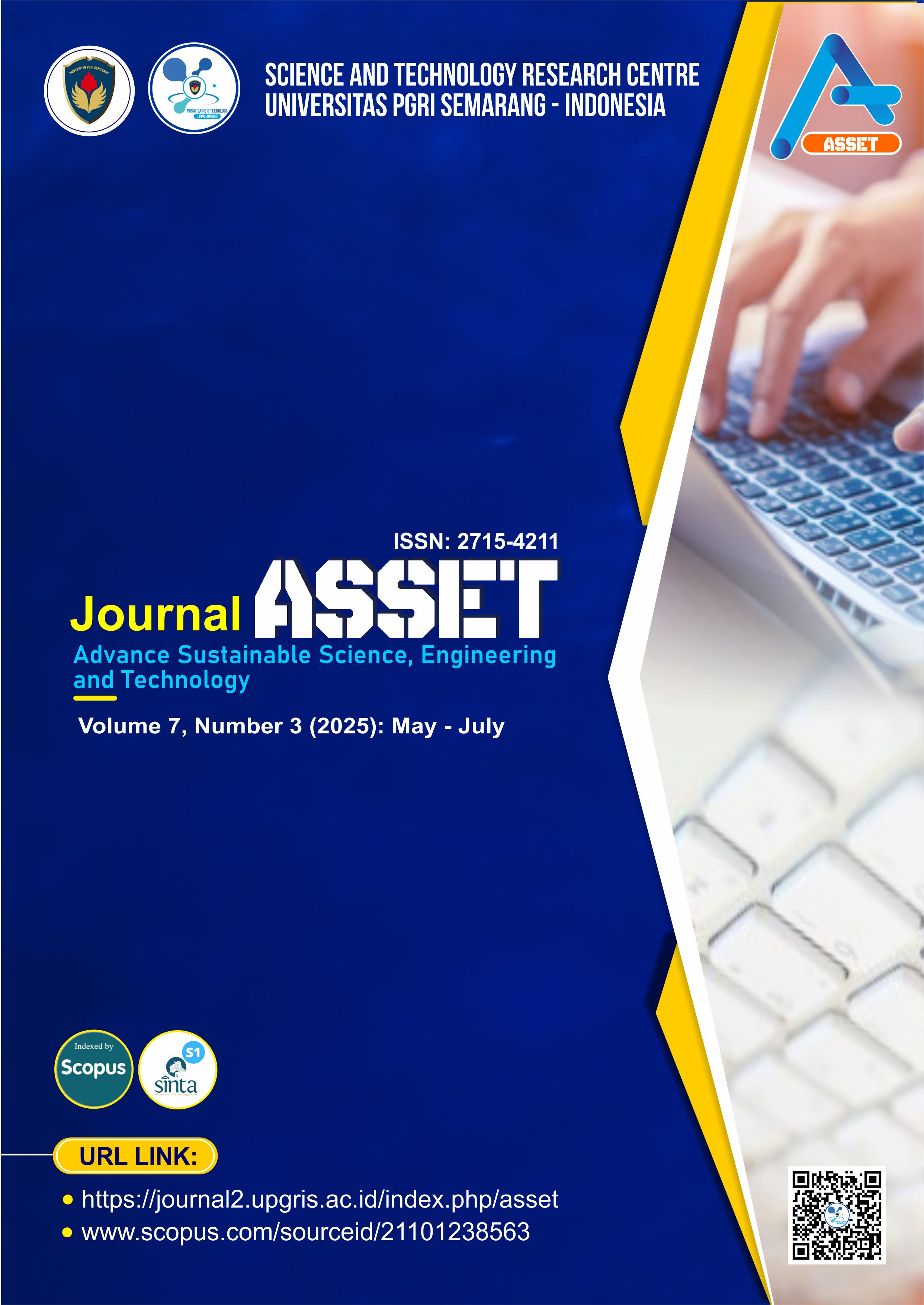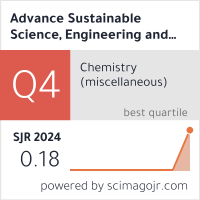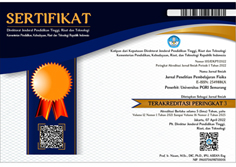Assessing Environmental Quality Using the Risk Screening Environmental Indicators (RSEI) Method: A Multi-Year Remote Sensing Approach
DOI:
https://doi.org/10.26877/asset.v7i3.1766Keywords:
Environmental indicators, Landsat imagery, Spatiotemporal analysisAbstract
Industrial areas in Indonesia are increasing every year with a total of 136 industrial estates in 2024, of which 61.76% are in Java, such as Kendal Industrial Estate (KIE) with an increase in built-up land of 289.52 hectares (2015-2017). The problem is that the development was carried out by converting vegetation cover. The purpose of the study was to analyze the impact of the increase in built-up land on the environmental quality index around Kendal Industrial Estate. Research method with supervised classification Random Forest method and spectral transformation Risk Screening Enviromental Indicators with indicators of greenness index, humidity Index, dryness Index and heat index with Principal Component Analysis technique. The results showed that built-up land around KIE increased by 894.17 hectares which resulted in a decrease in vegetation cover of 184.71 hectares (2015-2024), this phenomenon had an impact on increasing low-level RSEI by around 2,028.31 hectares (2015-2024). The regression results show that the increase in built-up land and the reduction of vegetation cover have an impact on the decline in environmental quality in the study area. The contribution of the research results can be used as a database for regulation of land use change restrictions.
References
[1] Reyseliani N, Hidayatno A, Purwanto WW. Implication of the Paris agreement target on Indonesia electricity sector transition to 2050 using TIMES model. Energy Policy [Internet]. 2022;169(August):113184. Tersedia pada: https://doi.org/10.1016/j.enpol.2022.113184
[2] Thorbecke W. Sectoral evidence on Indonesian economic performance after the pandemic. Asia Glob Econ [Internet]. 2023;3(2):100069. Tersedia pada: https://doi.org/10.1016/j.aglobe.2023.100069
[3] Haryanto T, Erlando A, Utomo Y. The Relationship Between Urbanization, Education, and GDP Per Capita in Indonesia. J Asian Financ Econ Bus. 2021;8(5):561–72.
[4] Alola AA, Rahko J. The effects of environmental innovations and international technology spillovers on industrial and energy sector emissions – Evidence from small open economies. Technol Forecast Soc Change [Internet]. 2024;198(November 2023):123024. Tersedia pada: https://doi.org/10.1016/j.techfore.2023.123024
[5] Sidiq WABN, Fariz TR, Saputro PA, Sholeh M. Built-Up Development Prediction Based on Cellular Automata Modelling Around New Yogyakarta International Airport. Ecol Eng Environ Technol. 2024;25(1):238–50.
[6] Schlüter L, Mortensen L, Gjerding AN, Kørnøv L. Can we replicate eco-industrial parks? Recommendations based on a process model of EIP evolution. J Clean Prod. 2023;429(July).
[7] Perdinan, Tjahjono REP, Infrawan DYD, Aprilia S, Adi RF, Basit RA, et al. Translation of international frameworks and national policies on climate change, land degradation, and biodiversity to develop integrated risk assessment for watershed management in Indonesia. Watershed Ecol Environ [Internet]. 2024;6(June 2023):1–12. Tersedia pada: https://doi.org/10.1016/j.wsee.2023.10.001
[8] Afshari H, Farel R, Peng Q. Challenges of value creation in Eco-Industrial Parks (EIPs): A stakeholder perspective for optimizing energy exchanges. Resour Conserv Recycl [Internet]. 2018;139(February):315–25. Tersedia pada: https://doi.org/10.1016/j.resconrec.2018.09.002
[9] Cholis MRN, Yulianti I, Fianti F. Analysis of Kendal Industrial Estate (KIK) impact on the Surrounding Air Quality. Phys Commun. 2023;7(1):28–34.
[10] Sadewo MN, Buchori I. Simulasi Perubahan Penggunaan Lahan Akibat Pembangunan Kawasan Industri Kendal Landsat Multitemporal (KIK) Berbasis Cellular Automata. Maj Geogr Indones. 2018;32(2):115.
[11] Hasibuan HS, Tambunan RP, Rukmana D, Permana CT, Elizandri BN, Putra GAY, et al. Policymaking and the spatial characteristics of land subsidence in North Jakarta. City Environ Interact [Internet]. 2023;18(January):100103. Tersedia pada: https://doi.org/10.1016/j.cacint.2023.100103
[12] Zheng Z, Wu Z, Chen Y, Guo C, Marinello F. Instability of remote sensing based ecological index (RSEI) and its improvement for time series analysis. Sci Total Environ [Internet]. 2022;814:152595. Tersedia pada: https://www.sciencedirect.com/science/article/pii/S0048969721076737
[13] Nagara RP, Wibowo A. Identifying the Impact of Shoreline Change on Land Use in Bedono Village With Google Earth. J Community Based Environ Eng Manag. 2024;8(1):27–34.
[14] Xu H, Wang Y, Guan H, Shi T, Hu X. Detecting Ecological Changes with a Remote Sensing Based Ecological Index (RSEI) Produced Time Series and Change Vector Analysis. Vol. 11, Remote Sensing. 2019.
[15] Xu H, Wang M, Shi T, Guan H, Fang C, Lin Z. Prediction of ecological effects of potential population and impervious surface increases using a remote sensing based ecological index (RSEI). Ecol Indic. 16 Mei 2019;93:730–40.
[16] Yan X, Li J, Yang D, Li J, Ma T, Su Y, et al. A Random Forest Algorithm for Landsat Image Chromatic Aberration Restoration Based on GEE Cloud Platform—A Case Study of Yucatán Peninsula, Mexico. Vol. 14, Remote Sensing. 2022.
[17] Amalia A V., Fariz TR, Lutfiananda F, Ihsan HM, Atunnisa R, Jabbar A. Comparison of Swat-Based Ecohydrological Modeling in the Rawa Pening Catchment Area, Indonesia. J Pendidik IPA Indones. 2024;13(1):1–11.
[18] Maxwell AE, Warner TA, Fang F. Implementation of machine-learning classification in remote sensing: an applied review. Int J Remote Sens [Internet]. 3 Mei 2018;39(9):2784–817. Tersedia pada: https://doi.org/10.1080/01431161.2018.1433343
[19] Kadri N, Jebari S, Augusseau X, Mahdhi N, Lestrelin G, Berndtsson R. Analysis of Four Decades of Land Use and Land Cover Change in Semiarid Tunisia Using Google Earth Engine. Vol. 15, Remote Sensing. 2023.
[20] Ridho Fariz T, Nurhidayati E. Mapping Land Coverage in the Kapuas Watershed Using Machine Learning in Google Earth Engine. J Appl Geospatial Inf. 7 Agustus 2020;4:390–5.
[21] Hu X, Xu H. A new remote sensing index for assessing the spatial heterogeneity in urban ecological quality: A case from Fuzhou City, China. Ecol Indic [Internet]. 2018;89(December 2017):11–21. Tersedia pada: https://doi.org/10.1016/j.ecolind.2018.02.006
[22] Liu Y, Zhang J. Spatio-temporal evolutionary analysis of surface ecological quality in Pingshuo open-cast mine area, China. Environ Sci Pollut Res. 29 Desember 2023;31:1–18.
[23] Islam M, Jimmy A, Alam Saimon MS, Khan N. The use of multi-temporal Landsat normalized difference vegetation index (NDVI) data for assessing forest cover change of Lawarchara National Park. Environ Dev Sustain. 1 Desember 2021;23.
[24] Chen C, Wang L, Yang G, Sun W, Song Y. Mapping of Ecological Environment Based on Google Earth Engine Cloud Computing Platform and Landsat Long-Term Data: A Case Study of the Zhoushan Archipelago. Vol. 15, Remote Sensing. 2023.
[25] Faliha Dzakiyah I, Saraswati R. Drought area of agricultural land using Tasseled Cap Transformation (TCT) method in Ciampel Subdistrict Karawang Regency. E3S Web Conf. 2020;211:1–10.
[26] Ticehurst C, Teng J, Sengupta A. Development of a Multi-Index Method Based on Landsat Reflectance Data to Map Open Water in a Complex Environment. Vol. 14, Remote Sensing. 2022.
[27] Zhou J, Liu W. Monitoring and Evaluation of Eco-Environment Quality Based on Remote Sensing-Based Ecological Index (RSEI) in Taihu Lake Basin, China. Vol. 14, Sustainability. 2022.
[28] Bidgoli R, Koohbanani H, Keshavarzi A, Kumar V. Measurement and zonation of soil surface moisture in arid and semi-arid regions using Landsat 8 images. Arab J Geosci. 1 September 2020;13.
[29] Fariz TR, Faniza V. Comparison of built-up land indices for building density mapping in urban environments. AIP Conf Proc [Internet]. 16 Mei 2023;2683(1):30006. Tersedia pada: https://doi.org/10.1063/5.0125378
[30] Alganci U. Dynamic Land Cover Mapping of Urbanized Cities with Landsat 8 Multi-temporal Images: Comparative Evaluation of Classification Algorithms and Dimension Reduction Methods. Vol. 8, ISPRS International Journal of Geo-Information. 2019.
[31] Li Y, Tian H, Zhang J, Lu S, Xie Z, Shen W, et al. Detection of spatiotemporal changes in ecological quality in the Chinese mainland: Trends and attributes. Sci Total Environ. Agustus 2023;884:163791.
[32] Zheng Y, He Y, Zhou Q, Wang H. Quantitative Evaluation of Urban Expansion using NPP-VIIRS Nighttime Light and Landsat Spectral Data. Sustain Cities Soc [Internet]. 2022;76:103338. Tersedia pada: https://www.sciencedirect.com/science/article/pii/S2210670721006144
[33] Meili N, Acero JA, Peleg N, Manoli G, Burlando P, Fatichi S. Vegetation cover and plant-trait effects on outdoor thermal comfort in a tropical city. Build Environ [Internet]. 2021;195:107733. Tersedia pada: https://www.sciencedirect.com/science/article/pii/S0360132321001426
[34] Anwar HMI, Saiful HAKM, Ataur I, Abul R, Bhuiyan E, Paul S. Impact of Land Cover Changes on Land Surface Temperature and Human Thermal Comfort in Dhaka City of Bangladesh. Earth Syst Environ [Internet]. 2021;5(3):667–93. Tersedia pada: https://doi.org/10.1007/s41748-021-00243-4
[35] Noori AR, Singh SK. Rainfall Assessment and Water Harvesting Potential in an Urban area for Artificial Groundwater Recharge with Land Use and Land Cover Approach. Water Resour Manag [Internet]. 2023;37(13):5215–34. Tersedia pada: https://doi.org/10.1007/s11269-023-03602-0
[36] Adekunle AO, Alice C-R, Vicente G. Factors Affecting Workforce Turnover in the Construction Sector: A Systematic Review. J Constr Eng Manag [Internet]. 1 Februari 2020;146(2):3119010. Tersedia pada: https://doi.org/10.1061/(ASCE)CO.1943-7862.0001725
[37] Liu Y, Zhou Y. Reflections on China’s food security and land use policy under rapid urbanization. Land use policy [Internet]. 2021;109:105699. Tersedia pada: https://www.sciencedirect.com/science/article/pii/S0264837721004221
[38] Amiri M, Pourghasemi HR. Chapter 8 - Mapping the NDVI and monitoring of its changes using Google Earth Engine and Sentinel-2 images. In: Pourghasemi HRBT-C in E and ES, editor. Elsevier; 2022. hal. 127–36. Tersedia pada: https://www.sciencedirect.com/science/article/pii/B9780323898614000440
[39] Erell E, Zhou B. The effect of increasing surface cover vegetation on urban microclimate and energy demand for building heating and cooling. Build Environ [Internet]. 2022;213:108867. Tersedia pada: https://www.sciencedirect.com/science/article/pii/S0360132322001135
[40] Bao Y, Gao M, Luo D, Zhou X. The Influence of Plant Community Characteristics in Urban Parks on the Microclimate. Vol. 13, Forests. 2022.
[41] Souza R De, Marques R, Falcão A, Joel DF. Thermal comfort conditions at microclimate scale and surface urban heat island in a tropical city : A study on João Pessoa city , Brazil. Int J Biometeorol [Internet]. 2022;1079–93. Tersedia pada: https://doi.org/10.1007/s00484-022-02260-y
[42] Tang H, Fang J, Xie R, Ji X, Li D, Yuan J. Impact of Land Cover Change on a Typical Mining Region and Its Ecological Environment Quality Evaluation Using Remote Sensing Based Ecological Index (RSEI). Vol. 14, Sustainability. 2022.
[43] Vujovic S, Haddad B, Karaky H, Sebaibi N, Boutouil M. Urban Heat Island: Causes, Consequences, and Mitigation Measures with Emphasis on Reflective and Permeable Pavements. Vol. 2, CivilEng. 2021. hal. 459–84.
[44] Basu T, Das A. Urbanization induced degradation of urban green space and its association to the land surface temperature in a medium-class city in India. Sustain Cities Soc [Internet]. 2023;90:104373. Tersedia pada: https://www.sciencedirect.com/science/article/pii/S2210670722006783











